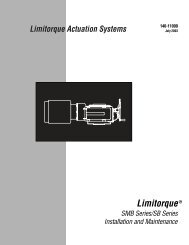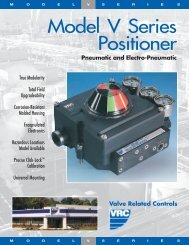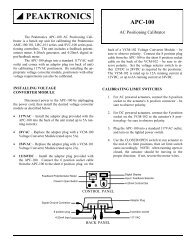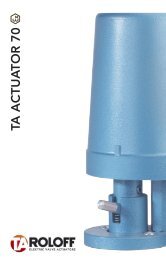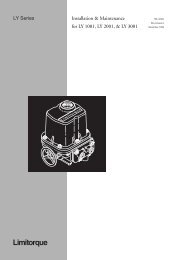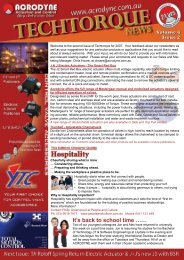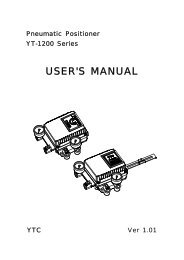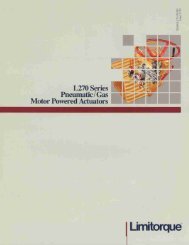Limitorque MX - Acrodyne
Limitorque MX - Acrodyne
Limitorque MX - Acrodyne
- No tags were found...
Create successful ePaper yourself
Turn your PDF publications into a flip-book with our unique Google optimized e-Paper software.
Foundation Fieldbus Communication<strong>MX</strong> can be fitted with Foundation Fieldbus protocol thatcomplies with the IEC 61158-2 Fieldbus H1 standard. Thefield unit device is able to support several topologies, suchas, point-to-point, bus with spurs, daisy chain, tree, or acombination of these. The FF device has network featuresthat include:• Link Active Scheduler that controls the system• High-speed communications up to 31.25 kbits/sec• Peer-to-peer communication• Input and output function blocks• Device descriptions• Network communication• Configurable by userLink Active Scheduler communication: Fieldbus segmentshave one active Link Active Scheduler (LAS) at a given time,which is the bus arbiter, and does the following:° Recognizes and adds new devices to the link° Removes non-responsive devices from the link° Schedules control activity in, and communicationactivity between, devices° Regularly polls devices for process data° Distributes a priority-driven token to devices forunscheduled transmissionsPROFIBUS DP V1/V2 Communication<strong>MX</strong> can be fitted with Profibus DP_V1/V2 protocol field unitsthat comply with EN50170 Fieldbus Standard for RS-485communications. The device supports several topologies,such as, point-to-point, bus with spurs, daisy chain, tree, ora combination of these. The PB device has network featuresthat include:• High-speed communications up to 1.5 m/bits/s• Master-to-slave and peer-to-peer communication• Stand-by communication channel• Analog & digital input and output function blocks• Device descriptions configurable by userHigh-Speed Data Exchange – Startup SequencePROFIBUS PA CommunicationA Profibus PA protocol is available and complies withEN50170 Fieldbus Standard and Fieldbus physical layerper IEC 61158-2 for communications. The device supportsseveral topologies, such as point-to-point, bus with spurs,daisy chain, tree, or a combination of these. The PB devicehas network features that include:• High-speed communications up to 31.25 kbits/s withManchester coding• Peer-to-peer communication• Bus powered for 9-32 VDC and 15 mA per actuator• Stand-by communication channel• Analog & digital input and output function blocks• Device descriptions• Configurable by userDeviceNetDeviceNet complies with CAN based protocol and providesthe following features:• DeviceNet Group 2 Server implementation.• Bus Powered Network Interface allows power alarminformation to be communicated when actuator looses mainpower. The actuator does NOT drop off the network when3-phase power is lost.• Standard Polled I/O Connection• Standard Bit Strobed I/O Connection• Standard Change of State / Cyclic I/O Connection• Standard explicit connections defined as:° Various Assembly Objects and sizes that allow thenetwork user to determine how much data to transferto accommodate network installation data throughputrequirements.° Automatic BAUD rate detection.° Node Address configurable via local setup menu, or viathe remote network user.° Broadcast or group network originated ESD support.14• Power ON / Reset – Power On / Reset of master or slave• Parameterization – download of parameters into field device(selected during configuration by the user)• I/O Configuration – download of I/O configuration into thefield device (selected during configuration by the user)• Data Exchange – cyclic data exchange (I/O Data) and fielddevice reports diagnostics



